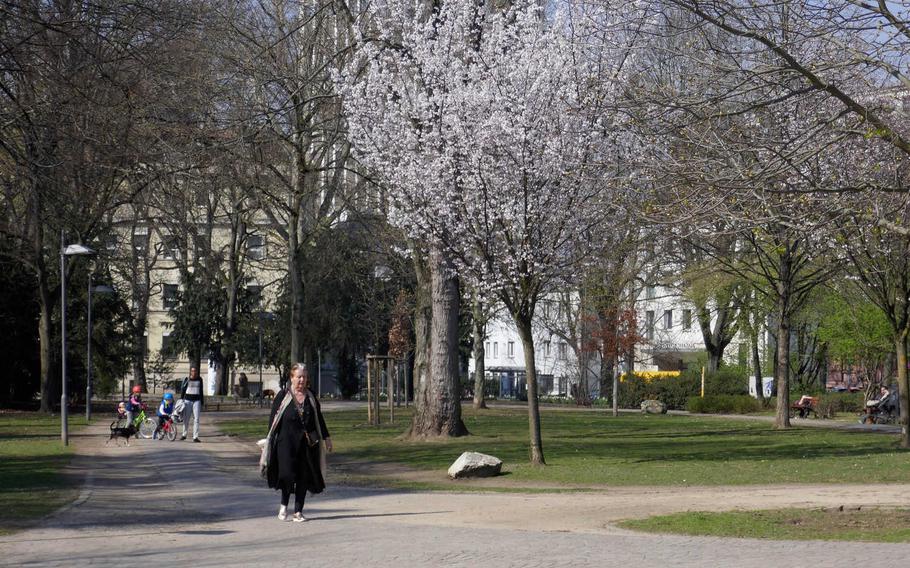
People walk through one of the parks that make up the Wallanlagen in Frankfurt am Main, Germany. The Wallanlagen is a greenbelt of parks surrounding the center of Frankfurt, north of the Main River, where the city's defensive walls once stood. (MICHAEL ABRAMS/STARS AND STRIPES)
Note: Restrictions related to the coronavirus change frequently. Please heed any rules and, if necessary, keep this in mind for a visit when things return to normal.
The medieval city walls couldn’t keep the Black Death out of Frankfurt in the 14th century, nor could they stop the next plague about 250 years later. If they still stood, they wouldn’t protect the city’s inhabitants from today’s coronavirus, either.
It was the advent of artillery that really made the walls obsolete, and in the early 19th century, they were torn down.
But this central German city on the Main River didn’t just build something new where the walls once stood. Frankfurt laid out parks or sold the land to citizens for gardens, keeping it green.
After World War II, Frankfurt bought up most of the private land and turned it into a greenbelt that surrounds the city center like the walls once did.
On a sunny, coronavirus-influenced day, I went for a walk through the Wallanlagen, as the string of seven parks are called.
I started on the eastern end, at the Obermainanlage, walking counterclockwise to the west.
The stroll took me past statues of famous people and works by known and unknown artists, past playgrounds, roped off because of the virus, and to small lakes and ponds.
It was quiet in the parks and although Germany’s two-person anti-coronavirus rule was still a couple of days away, there were no groups of people to be seen.
When walking, it sometimes pays to look beyond the green and across the street.
At the beginning of Friedberger Anlage you can see the Hochbunker, once a World War II bunker built on the site of a synagogue destroyed by the Nazis. Today it is an exhibit space. At the park’s other end, cross the street to Bethmannpark, a green expanse that features a Chinese garden.
Feeling a little dehydrated, I stopped for something to drink at Trinkhalle Fein, now a cozy cafe. There used to be more than 800 Trinkhallen (drink halls) and Wasserhaeuschen (little water houses) in Frankfurt, kiosks where in the 19th century, Frankfurters could buy clean bubbly drinking water and meet with their neighbors. Today there are less that 300 dotting the city.
A park within a park is the Buergergarten. Below street level, it is a quiet oasis in the busy city that features a sundial and a fountain that spouts water from Medusa’s head.
I stopped for lunch at Burger am Turm, a fast food joint — with delicious falafel — just around the corner from the Eschenheimer Tor, a gate tower that is one of the last remnants of Frankfurt’s medieval fortifications.
After lunch, I continued my stroll through the Bockenheimer Anlage, which Frankfurt American High School alumni might remember was a popular place to go when, uh, skipping school.
Although people were sitting alone or in pairs, the pond here was probably the most populated place on the stroll.
This park ends at the Alte Oper, the city’s former opera house — destroyed in WWII and rebuilt in the 1980s.
I decided to finish my walk through the Wallanlagen here. But the parks do continue back down to the banks of the Main.
Next time I go, I’ll continue there. But not until we all can go and do what we want, and not in these coronavirus times.
abrams.mike@stripes.com Twitter: @stripes_photog
DIRECTIONS: Frankfurt is in central Germany, about 25 miles from Wiesbaden and 60 miles from Kaiserslautern. The best place to park is south of the Main at the Alt Sachsenhausen garage, Walter-Kolb-Strasse 16, 60594 Frankfurt. It is one of the cheapest in Frankfurt at 1 euro per hour. Cross the Main to the northern bank and it is about a 10-minute walk along the river to the eastern end of the Wallanlagen. On the western end is the Alte Oper garage, Opernplatz 1, 60313 Frankfurt. It costs 2.50 euros an hour, 50 cents on Sundays.
TIMES: Any time, but of course it’s more pleasant when the weather is nice.
COSTS: Just parking, and whatever you eat and drink
FOOD: There are takeout places along the way, especially near the Eschenheimer Tor.